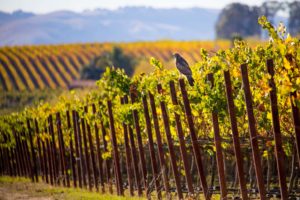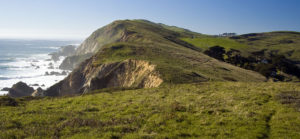Aged fence posts lean comfortably toward the golden field of wheat beside the McCormack Ranch’s dirt driveway. The road passes barns, grain silos, and an old farmhouse that Jeanne McCormack’s grandfather lived in over a century ago. Then it winds past a handful of walnut trees and another aged barn and along the banks of the Sacramento River.
And on both sides, the wheat fields stand in various stages of a three-year rotation: plowed, planted, and fallow.
But the 3,700-acre ranch on the outskirts of Rio Vista grows more than just wheat. Jeanne and her husband, Al Medvitz, believe in variety. Here in the rolling Montezuma Hills of rural Solano County, they also farm alfalfa and have a new 50-acre vineyard overlooking the river. And they raise pasture-fed sheep and Boer goats; in the early 1990s they were the first ranch to provide lamb to Niman Ranch.
“The more diversity we have, the more security we have,” says Medvitz. “This place has to be sustainable into the future, and diversity is a big part of that.”
Though the two have deep roots here, they don’t have typical ranch biographies. As a teenager, McCormack gladly left Rio Vista for UC Berkeley, later spending two years in Malawi with the Peace Corps. She met Medvitz while they were in grad school at Harvard. Both got involved in international aid work often related to agriculture: Medvitz wrote for a New Guinea farming guide, and McCormack worked with women’s microenterprise in Kenya. Then, as McCormack’s parents grew older, she and Medvitz considered returning to the ranch.
“For me it was a personal experiment,” Medvitz says. “Here I was writing a curriculum based on agriculture, and I couldn’t grow a tomato.”
- The open fields of McCormack Ranch, near Rio Vista in Solano County, border the Sacramento River and look out on Mount Diablo in the distance. Photo by Stephen Joseph, stephenjosephphoto.com.
Learning to run a ranch that covers nearly six square miles was both daunting and exhilarating. And over the last three decades, the couple developed a vibrant business combining her family’s farming traditions with their own commitment to land stewardship. “We are carrying on completely in spirit and partially in letter the way the ranch has been operated for 120 years,” McCormack says.
Though her father would have scoffed at the term “sustainable,” that’s really how he operated, she adds. He rotated his pastures through a three-year cycle, alternating grazing and wheat cultivation, which protected the soils and kept down the weeds. He believed in bringing as little into the farm from outside as he could, so he didn’t use chemical fertilizers or much purchased feed.
And that’s the way that McCormack and Medvitz operate today. “One of the things we brought with us was a very strong commitment to the ranch as an important piece of the environment, and we had been given custody of the place,” Medvitz says. “At the time, the idea of sustainability was just coming out. By coincidence we kind of met the market.”
In their early years on the ranch, prices were low. One year McCormack took her mother’s Christmas card list and mailed everyone an invitation to buy boxed lamb. They sold 50 animals that year, and eventually a cousin introduced them to Bill Niman, who began selling their lamb. Within five years demand was so high they brought their neighbors in on the business.
Today they still market their lamb to Niman Ranch. They also sell pasture-raised goat to high-end restaurants such as Cafe Rouge in Berkeley and Prospect in San Francisco. Their wheat and wool go to wholesalers. And soon their vineyard will produce wine grapes to sell to Gallo.
“We’re trying to produce great food and maintain the health of the animals and the land at the same time,” says McCormack. “I feel that what we do is noble, I really do. It’s an unbelievable opportunity to do this work.”
Learn more at mccormackranch.com.
Find more Food Landscapes resources at baynature.org/foodlandscapes.

.jpg)




